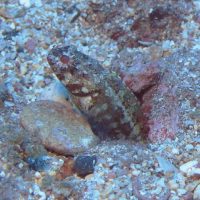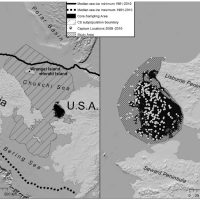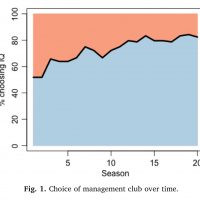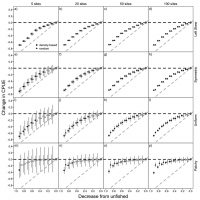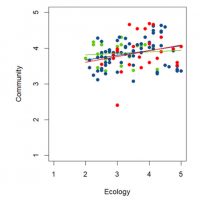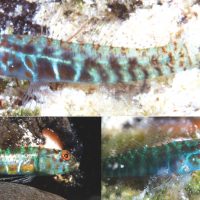Filter Results
Micro-slices of fish scales reveal effects of dams on lungfish diet
Australian lungfish are living fossils that have survived virtually unchanged since their appearance in the fossil record 340 million years ago. They are well known to have the nifty ability to survive for several days out of water. Now, a new study uses their scales to infer what they ate over periods of more than 50 years. The new technique first ages the lungfish by measuring radioactive signatures in the scales that track radioactivity from nuclear weapons testing in the 1950s and 1960s, and then having dated micro-slices of the fish scales, each slice is examined for carbon and nitrogen isotopes that unveil their food sources throughout their life.
Read moreTwo new species of male mouth-brooding fish described
Two new species of jawfishes (family Opistognathidae) have been described for the first time this month. These small fish have fascinating life histories, digging burrows in sandy bottoms near reefs, and relying on males to brood eggs in their mouths. Each burrow houses one fish, and they strongly defend their burrows. The first new species, Thionyi’s jawfish (Opistognathus thionyi), is found in Vitória-Trindade Chain and Fernando de Noronha Archipelago off Brazil; while the second new species, the Brazilian dusky jawfish (Opistognathus vicinus), is found off mainland Brazil.
Read moreLittle change in polar bear numbers in the Chukchi Sea
Polar bears, like other large predators, are hard to track and count, and available data is often fragmentary and difficult to piece together. Now, a new model provides estimates for key parameters for polar bears in the Chukchi Sea off north-western Alaska, by combining available data from telemetry, marking and recapturing, and counts. The model estimates that 83% of females give birth every year, that litter sizes are 2.11 per year, and that survival is about 90% for both males and females.
Read moreFish processors pay higher prices after individual quotas
Individual fishing quotas have been introduced to the Pacific whiting fishery off the US west coast, involving allocating rights to fish quota to both harvesters (80%) and processors (20%) and letting individuals decide when and how to to catch and land fish. A unique dataset of prices and costs allowed researchers to examine the impact of this change on land-based processors.
Read moreStrong individual rights emerge naturally in gaming experiments
Many natural resources, such as grazing lands, forests, and fisheries, can be managed either by lots of people communally (common property), by top-down regulation, or by individual rights. A new analysis shows experimentally that individual rights emerge as the preferred choice when people are given freedom to choose among different clubs that each decide how to manage part of the resource.
Read moreToo many fish, too few hooks: examining bias in hook-and-line surveys
Scientific surveys using fishing rods, each fishing multiple hooks, have the advantage of being able to access rocky areas while obtaining samples of fish for length and age estimation. However, in areas with lots of fish, it is possible for nearly every hook to catch a fish, resulting in an upper limit on the number of fish that can be counted.
Read moreFantastic beasts and where to find them
New and weird species are being discovered all the time, and the latest is the Narungga Frogfish (Histiophryne narungga), which has just been described. The name honors the Narungga tribe of indigenous Australians who traditionally inhabited the lands in which it was found. The new species comes in a variety of dotted forms, occurs in southern and western Australia, and is a member of the order Lophiiformes.
Read moreThe three pillars of fisheries sustainability
Fisheries management is often seen as a balancing act that aims for economic development, environmental protection and social development. Previous work shows that overfishing or other forms of poor ecological health, reduces economic profits; and it has long been assumed that pursuit of profits leads to poor social outcomes for fishing communities. But now a new analysis of 121 fisheries worldwide suggests this second assumption may not hold, based on scores of 68 different ecological, economic, and social metrics for each fishery.
Read moreNewly discovered fish species: the Polkadot Dwarfgoby
Oceanic discoveries of new species continue at pace, with a new species added to the 34,000 previously described: the Polkadot Dwarfgoby (Eviota maculosa). The new species occurs in New Guinea, Indonesia, and Pohnpei in the Federated States of Micronesia, and is distinguished by unique fin patterns, distinctive genetics, and multiple rows of trident-like teeth in both the upper and lower jaws.
Read moreDoes more fish mean more money?
Bristol Bay in Alaska hosts one of the world’s largest salmon fisheries every year, targeting bountiful runs of sockeye salmon. The fishery is managed using escapement goals that ensure sufficient salmon escape the fishery every year to spawn upriver. Recently, increased escapement goals were proposed for Bristol Bay that were intended to allow more salmon to spawn upriver, because of calculations suggesting this would lead to larger average catches.
Read more